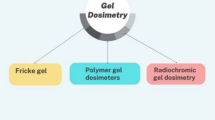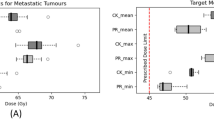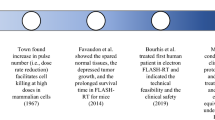Abstract
The Relative biological effectiveness (RBE) plays an important role in designing a uniform dose response for ion-beam therapy. In this study, the biological effectiveness of a carbon-ion beam delivery system was investigated using Monte Carlo simulations. A carbon-ion beam delivery line was designed for the Korea Heavy Ion Medical Accelerator (KHIMA) project. The GEANT4 simulation tool kit was used to simulate carbon-ion beam transport into media. An incident energy carbon-ion beam with energy in the range between 220 MeV/u and 290 MeV/u was chosen to generate secondary particles. The microdosimetric-kinetic (MK) model was applied to describe the RBE of 10% survival in human salivary-gland (HSG) cells. The RBE weighted dose was estimated as a function of the penetration depth in the water phantom along the incident beam’s direction. A biologically photon-equivalent Spread Out Bragg Peak (SOBP) was designed using the RBE-weighted absorbed dose. Finally, the RBE of mixed beams was predicted as a function of the depth in the water phantom.
Similar content being viewed by others
References
W. T. T. Chu et al., IAEA Technical Documents (2006).
IAEA Technical Report Series No. 461.
T. Kamada et al., Lancet. 16, 2 (2015).
M. Joiner and A. Kogel, Basic Clinical Radiobiology (CRC Press, UK, 2009).
T. Kanai, Y. Furusawa, K. Fukutsu, H. Itsukaichi, K. E. Kasai and H. Ohara, Radiat. Res. 147, 78 (1999).
T. Kanai et al., Int. J. Radiat. Oncol. Biol. Phys. 44, 201 (1999).
A. M. Kellerer and H. H. Rossi. Radiat. Res. 75, 471 (1978).
M. Scholz, A. Kellerer, W. K. Weyrather and G. Kraft, Radiat. Environ. Biophys. 36, 59 (1997).
T. Elsasser and M. Scholz, Radiat. Res. 167, 319 (2007).
O. Steinstrater, R. Grun, U. Scholz, T. Friedrich, M. Durante and M. Scholz, Int. J. Radiat. Oncol. Biol. Phys. 84, 854 (2012).
R. Rossy, Eur. Phys. J. Plus. 126, 78 (2011).
R. B. Hawkins, Radiat. Res. 140, 366 (1994).
R. B. Hawkins, Radiat. Res. 160, 61 (2003).
Y. Kase, T. Kanai, Y. Matsumoto, Y. Furusawa, H. Okamoto, T. Asaba, M. Sakama and H. Shinoda, Radiat. Res. 166, 629 (2006).
T. Sato, Y. Kase, R. Watanabe, K. Niita and L. Sihver, Radiat. Res. 171, 107 (2009).
T. Inaniwa, T. Furukawa, Y. Kase, N. Matsufuji, T. Toshito, Y. Matsumoto, Y. Furusawa and K. Noda, Phys. Med. Bio. 55, 6721 (2010).
D. Dabli, G. Montarou, M. Beuve and C. R. Lafrasse, RBE modelization: Present Status and Future Prospects (2011), p. 22.
C. H. Kim et al., J. Korean Phys. Soc. 45, 1000 (2014).
C. H. Kim et al., J. Korean Phys. Soc. 64, 1308 (2014).
S. Giordanengo et al., NIM A 698, 202 (2013).
S. Agostinelli et al., NIM A 506, 250 (2003).
Geant4 Hadronic Working Group, Improvements in the Geant4 Hadronic Physics, CHEP 2010.
G. Cirrone et al., Prog. Nucl. Sci. 2, 207 (2011).
M. Sakama et al., Phys. Med. Bio. 57, 6615 (2012).
ICRU Report 60.
F. Romano, G. A. P. Cirrone, G. Cuttone, F. D. Rosa, S. E. Mazzaglia, I. Petrovic, A. R. Fira and A. Varisano, Phys. Med. Bio. 59, 2863 (2014).
MINUIT, A physics analysis tool for function minimization, http://www.cern.ch/minuit.
ROOT, An object oriented framework for large scale data analys. http://root.cern.ch.
Y. Furusawa, K. Fukutsu, M. Aoki, H. Itsukaichi, K. E. Kasai, H. Ohara, F. Yatagai, T. Kanai and K. Ando, Radiat. Res. 154, 485 (2000).
T. Inaniwa, M. Suzuki, T. Frukawa, Y. Kase, N. Kanematsu, T. Shirai and R. B. Hawkins, Radiat. Res. 180, 44 (2013).
Author information
Authors and Affiliations
Corresponding author
Rights and permissions
About this article
Cite this article
Cho, I., Yoo, S., Cho, S. et al. Modeling the biophysical effects in a carbon beam delivery line by using Monte Carlo simulations. Journal of the Korean Physical Society 69, 868–874 (2016). https://doi.org/10.3938/jkps.69.868
Received:
Accepted:
Published:
Issue Date:
DOI: https://doi.org/10.3938/jkps.69.868




